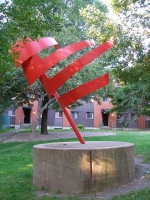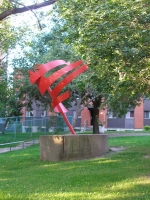F. Maurice Lemieux
À voile déchirée
1972
Presentation of the artwork
The work is situated in the back courtyard of the De Maisonneuve housing project. It is an abstract sculpture composed of four curved elements in a horizontal line and supported by a pipe. The asymmetrical composition is oblique. The elements are made of steel and painted bright red. The concrete base is cylindrical. The artist’s daughter, Francine Lemieux, said about the sculpture, “Like a sailboat drifting on the ocean with a torn sail; our pioneers had to face the obstacles that life threw at them by being tenacious and courageous.”
Associated events
The artwork was commissioned by architectural firm Dupuis et Mathieu, in compliance with the “1 percent policy” instituted by the Ministère des Travaux publics et de l'Approvisionnement du Québec.
F. Maurice Lemieux
After attending the École d’Arts et Métiers de Valleyfield, Maurice Lemieux (1931–94) produced his first sculptures in the 1950s. He participated in the Madrid Biennale in 1957 and created an imposing wall sculpture for the Séminaire Saint-Jean-Iberville (today CÉGEP Saint-Jean-sur-Richelieu) in 1961. Between 1964 and 1971, he lived in Los Angeles, where he developed a new material that he called “aluminum foam.” In the early 1980s, he created Calcite, a permanent artwork for the De la Savane Métro station in Montréal.
Presentation of the artwork
The work is situated in the back courtyard of the De Maisonneuve housing project. It is an abstract sculpture composed of four curved elements in a horizontal line and supported by a pipe. The asymmetrical composition is oblique. The elements are made of steel and painted bright red. The concrete base is cylindrical. The artist’s daughter, Francine Lemieux, said about the sculpture, “Like a sailboat drifting on the ocean with a torn sail; our pioneers had to face the obstacles that life threw at them by being tenacious and courageous.”
Associated events
The artwork was commissioned by architectural firm Dupuis et Mathieu, in compliance with the “1 percent policy” instituted by the Ministère des Travaux publics et de l'Approvisionnement du Québec.
F. Maurice Lemieux
After attending the École d’Arts et Métiers de Valleyfield, Maurice Lemieux (1931–94) produced his first sculptures in the 1950s. He participated in the Madrid Biennale in 1957 and created an imposing wall sculpture for the Séminaire Saint-Jean-Iberville (today CÉGEP Saint-Jean-sur-Richelieu) in 1961. Between 1964 and 1971, he lived in Los Angeles, where he developed a new material that he called “aluminum foam.” In the early 1980s, he created Calcite, a permanent artwork for the De la Savane Métro station in Montréal.






